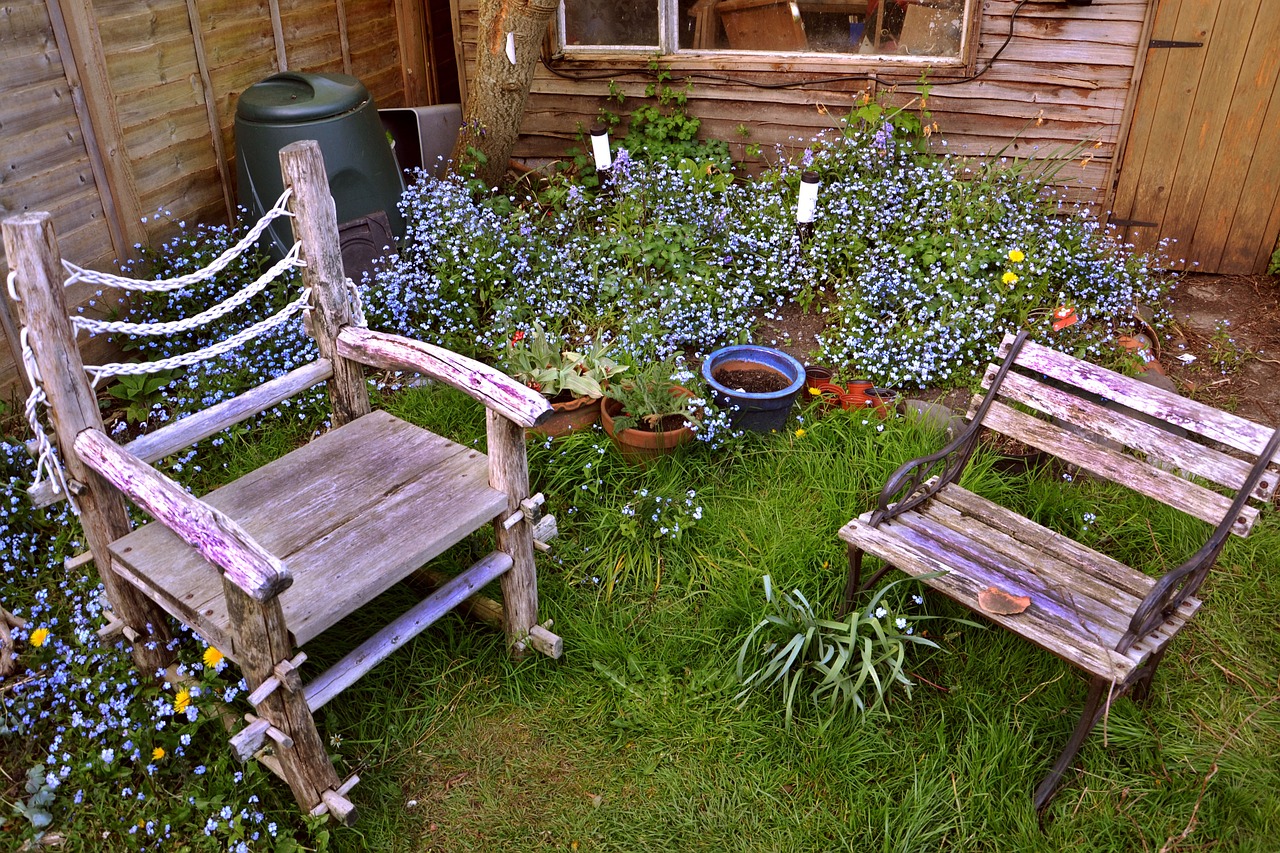Turn your tiny backyard into an enchanting OASIS! With our easy steps, learn to maximize space—whether creating a cozy corner or vibrant garden. Embrace creative solutions and watch your bland backyard transform into a delightful outdoor haven. Ready to DIG IN? Let’s get started!
Requirements
You’ll need basic gardening tools, decorative elements like charming lights or quirky statues, select plants, a dash of creativity, and a sprinkle of patience.
Transform Your Backyard: Stunning DIY Projects for Comfort and Beauty
Step 1: Declutter and Clean
Is Your Backyard a Hidden Gem or a Junkyard?Start your backyard makeover by tackling clutter like you’re on a mission from a home improvement show—a backyard detox awaits! First, ditch unnecessary items that have accumulated over time. Think of those rusty garden gnomes, deflated soccer balls, and half-empty bird feeders. Sentimental or useful? Keep them! Otherwise, it’s time for a yard sale or a trip to the donation center.
Next, tame overgrown flora. Channel your inner Edward Scissorhands and give unruly bushes a much-needed haircut. Weed out those ornery dandelions and invasive vines quicker than you can say “weed-be-gone.” Clear out dead branches and fallen leaves with a swift rake-off.
Don’t forget to sweep away debris from patios and pathways to reveal their original glory. A little elbow grease goes a long way—grab a garden hose or pressure washer and give surfaces a sparkling clean-up. Don’t let old grime overshadow your outdoor space’s natural charm. The clearer the canvas, the more you’ll see its potential! Your backyard is now ready for a fresh start, so prepare to unleash your inner landscaper genius!
Step 2: Plan Your Layout
Crafting the Perfect Blueprint for Your Backyard ParadiseSketch out your dream backyard like you’re crafting a masterpiece—paper and pencil at the ready! First, measure your yard to understand its dimensions. Think of it as giving your future plans a stage to shine on. Once you know what you’re working with, it’s time to imagine possibilities.
Want a cozy seating area where lazy afternoons whisper sweet nothings? Mark that spot. How about a mini-garden to flex your green thumb? Add a dotted line or two for raised beds or a handy herb corner. Feel the urge for a zen oasis, bamboo and all? Circle a tranquil nook for your meditation retreat.
Be mindful of your yard’s existing features—trees, sheds, or the neighbor’s friendly cat’s shortcut. These natural (or not-so-natural) elements should inform your layout to create flow. Mix functionality and fun! Install a small trellis for a vertical garden, or leave room for a quirky wind chime ensemble.
Remember, in small spaces, every square foot is prime real estate—like finding the perfect shoes that both impress and fit like a glove. So, think big, even when the space is snug, and craft a layout that’s uniquely you!
Step 3: Select the Right Plants
Think Small, Grow Big: The Secret to Lush GreenerySprinkle a splash of green on your backyard canvas with plants that love small spaces like homebodies love cozy corners. Choose flora that thrives in your local conditions, lest you create a “Garden of Woe.” For micro-backyards, vertical gardening is your secret weapon—go up, not out! Install a trellis and watch your backyard envy soar like your climbing roses or sweet peas.
Hanging planters are perfect for cascading blooms. Imagine vibrant petunias spilling like a floral waterfall—instant eye candy! Feeling fancy? Tiered arrangements aren’t just for extravagant wedding cakes; stack pots or shelves to add green layers and visual interest.
Mix it up with a riot of colors and textures. Contrast is key! Deep purple lavender nestled against feathery ferns can turn bland into grand. Create a story with your plant choices: cheerful sunflowers nodding towards the sun, a patch of aromatic basil whispering “pesto”, or zen-like succulents holding a stoic pose next to whimsical ornamentals.
Jumpstart your green paradise, and before you know it, your backyard will be blooming with character—and maybe inspire that nosy neighbor to gamble on greenery too!
Step 4: Add Decorative Elements
Twinkle, Twinkle Little Yard: Lighting and Decor MagicTransform your backyard from “meh” to magnificent with the power of decorative elements. Drape fairy lights across trees or pergolas for a twinkling nighttime retreat that screams “festive” even when you’re just sipping tea. Speaking of magic, a garden statue or quirky gnome can be your garden’s silent guardian, adding personality and sparking conversations (or at least amusing glances).
For a touch of Zen, consider adding a small water feature. Imagine the tranquil sound of a bubbling mini-fountain—it’s the ultimate ‘ahh’ moment. Outdoor rugs and colorful cushions are your best friends when it comes to injecting warmth and color. Picture yourself lounging on bright pillows as if the Mediterranean Sea is your constant backdrop.
Remember, it’s all about the details. Even simple additions like wind chimes can turn a breezy day into a symphony of gentle notes. So sprinkle a little charm with each thoughtful piece, and before you know it, your backyard won’t just look better—it’ll feel like an extension of your personal style and hospitality.
Step 5: Create Comfortable Seating
Sit Back and Relax: Design Your Perfect Outdoor EscapeTransform that small patch of grass into the ultimate chill zone! Start by adding comfy seating options. Picture this: a hammock strung invitingly between trees, ready to cradle you during Sunday siestas. If you’re short on space, consider foldable chairs or multifunctional furniture. These nifty options can unfold into bonus seating or tuck away nicely when not in use—perfect for spontaneous gatherings or a dance-off under the stars.
Introduce some soft pillows and throws to turn chairs into cloud-like thrones. The magic combo of a comfy seat with a fluffy throw is your ticket to endless daydreaming sessions. Now imagine, a corner dedicated to a small bench, adorned with vibrant cushions—voilà, your backyard just whispered, “Stay a little longer.”
Let your personality shine through by choosing pieces that match your style. Whether it’s sleek and modern or quaint and bohemian, make sure your seating shouts “come relax with me!” Ultimately, a comfy seat isn’t just about resting your legs; it’s about creating a space so inviting that you’ll have to set a timer to remind yourself to head back indoors!
Conclusion
A small backyard can bring immense joy! By following these steps, you’ll create a haven that beautifully reflects your style. So, roll up your sleeves and give it a try! Share your backyard transformation stories with us – we can’t wait to see the magic!











Not too impressed. The decorative elements section felt a bit generic. I was hoping for more innovative ideas. 😕 Any tips for incorporating DIY projects?
Henry, Pinterest has tons of DIY backyard décor projects that are budget-friendly!
Sorry to hear that, Henry. For DIY ideas, try repurposing old furniture or using pallets for planters!
I followed this guide last weekend, and my backyard looks like a different place. The kids even love the new plant selection. 🌸
That’s awesome, Daniel! Kids can be picky, so that’s a win!
Happy to hear that, Daniel! Enjoy your revamped space.
I wish there was more on lighting options for small spaces. Fairy lights are great, but are there other creative ideas out there?
Rachel, solar-powered lanterns could add charm without needing outlets.
We’ll definitely consider adding lighting tips in our next update. Thanks for the suggestion!
I love how you included a section on planning the layout. Honestly, I had no idea how to arrange my furniture and plants. I always ended up blocking pathways. 😂 The diagrams really helped visualize different options.
Thomas, try using chalk to outline different areas before moving heavy stuff. Saved me a ton of effort!
Glad you liked the diagrams! They’re a great tool to play around with different ideas.
Right? The layout tips were so practical. My backyard looks way less chaotic now.
I was skeptical at first, but the decluttering step made an immediate difference. It’s like a breath of fresh air, literally. 😂 Now to tackle the seating!
Just wait till you add seating, Lucas. It’ll feel like a whole new world.
Decluttering really is underrated. Makes everything else so much easier.
Glad you’re seeing results, Lucas! Keep us posted on your progress.
I’m stuck on planning my layout. My space is awkwardly shaped—any advice? It’s long and narrow, with no clear sections. 🤔
Consider using vertical elements to create separation without blocking the view.
Chris, try dividing it into zones. Maybe a small dining area at one end?
Awesome guide! 🌿 I was so lost on where to begin, but your step-by-step made it feel doable. My backyard is tiny and was cluttered with old garden tools and toys. After decluttering, I can actually see the potential for a cozy corner. Excited to try out the plants section next!
Same here! Decluttering was a game-changer. Can’t believe how much space I was wasting.
Glad you found it helpful, Emily! Feel free to share pics of your progress.
The bit about choosing the right plants was super helpful. I had no idea some plants didn’t thrive in shady spots. 🌥️ Thanks for saving my hydrangeas!
Happy to help, Olivia! Plant placement can make all the difference.
Pro tip: Check local plant shops for advice on native plants. They usually need less maintenance!
I had the same issue with my ferns. Now they’re thriving because I moved them to a shady spot!
The seating area tips were spot on. I never considered adding a swing chair in a small space. Now, it’s my favorite spot to have morning coffee. ☕
Great choice, Sarah! A swing chair can be a lovely addition.
I bet it’s hard not to fall asleep there! 😂
Sarah, swing chairs are the best! I added cushions and it’s so cozy.
Super informative article! I always thought my tiny backyard was hopeless. Thanks to your guide, I see so many possibilities now, especially with the seating arrangements. 😊
Emma, transforming small spaces can be so rewarding! Good luck!